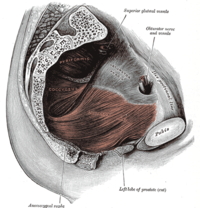
Photo from wikipedia
Objective: This study aims to evaluate the subjective and objective outcomes of the transobturator tape (TOT) procedure performed to treat stress urinary incontinence and to determine the efficacy and safety… Click to show full abstract
Objective: This study aims to evaluate the subjective and objective outcomes of the transobturator tape (TOT) procedure performed to treat stress urinary incontinence and to determine the efficacy and safety of the TOT procedure when used along with vaginal surgery. Methods: This is a prospective review of 24 women who had the TOT procedure done only due to stress incontinence; 22 women who underwent concomitant TOT and pelvic floor repair; and 20 women who received concurrent TOT, transvaginal hysterectomy, and sacrospinous ligament fixation. Results: When compared to the patients who had TOT with pelvic floor repair, the patients who underwent TOT with hysterectomy declared to have more dyspareunia (p = 0.008) and they were found to have significantly higher post-void residual volume (p = 0.014). When compared to the patients who had only TOT, the patients who underwent TOT with hysterectomy claimed to have more pelvic pain (p = 0.012) and significantly higher post-void residual volume (p = 0.020). Conclusion: The TOT procedure results in moderately high objective cure rates, and concurrent application of pelvic floor repair or transvaginal hysterectomy does not affect these rates. The relatively higher incidences for voiding problems and pelvic pain in women who underwent TOT, hysterectomy, and sacropinous fixation simultaneously suggest that the extent of surgery directly correlates with the severity of postoperative complications.
Journal Title: Urologia Internationalis
Year Published: 2018
Link to full text (if available)
Share on Social Media: Sign Up to like & get
recommendations!